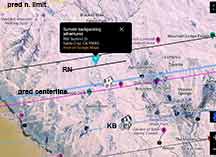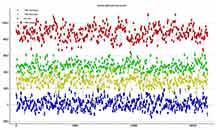

This is a high rank event, high enough in altitude to be do-able. It lasts 0.9s and so with an acceptable integration of say 8x, this should be detectable. Karl's on the centerline, so I'm trying to see if he's up for trying it. If so, Kirk and I would have to re-think where to go, probably farther north and higher, since the centerline also goes across the BD Airport.
 |
 |
The formal odds of a "hit" are high. 100% for our sites.

Fog came in to cover Santa Cruz. I'd set Sunlit Lane as my spot, but it turned out Karl was game too, and his track was identical to Sunlit Ln, so I instead drove further up to Vick Rd and found a good quiet spot with a perfect southern horizon even to very low altitude in places. Kirk set up at "the Berm", so we got some spread in our locations. Kirk could see a ~1s event on his live monitor at 16x, I was at 8x and on my flip-out screen could not see the target, so it will await reduction. But Kirk's positive gives hope that all 3 of us got a positive.
This event was a surprise, showing up on my feed only less than a day before the event. It was a discovery by Mike Skruskie, who then got uploaded to the OW feeds (somehow) and it showed up for me. So my announcement to Team Santa Cruz was very late. This time, due to the late posting on my OW feed. In fact, it never did show up on Kirk's feed even though he's as subscribed to all feeds as I am and with generous limits. It should have been there. There continue to be strange behaviors from OW desktop.
long 122 08 32.82
lat 37 05 29.58
elev 2436 ft
I wanted to stay off Karl's track and so even though the fog level was quite low, I continued past Sunlit Lane and tried to find the nice spot I was at several years ago, I thought on Vick Rd. But since then, the CSU fire had decimated that neighborhood, and I couldn't recognize anything I saw. But I did find a good spot, 0.2 miles from Empire Grade, on a connector road that looked now abandoned to the fire. Perfect for low southern occultations. I integrated at 8x.
I still need to look at Karl's "measles" recording to see if I can find the target star. He should have had an event. I am guessing that I had a single integration event, but not enough of a dip for PyOTE to find it in the noise. My drop was the deepest drop of the entire light curve, but will require a re-analysis for short events...
Kirk must have been on the centerline for a 1.06s event on a 0.9s max predicted event. Unless the asteroid was very squashed, I should have had ant event, as the OW map below would indicate. I did have 2 consec integrations at the low of ~sky level, and a 3rd that was nearly as low, and another on the other side below avg, but bracketed by 2 high points, all of which made it look not quite of sure significance in PyOTE "stand on its own" judgment. We needed long integrations for this faint star at low-ish altitude.
 |
 |
 |
 |
 |
 |
The interpolated center of my possible event, along the time line in PyOTE is at 15.56. Now subtract the 1/2 integration interval setting (8x = 16/50th seconds and 1/2 of that is 0.16s. So subtract 15.56-.16 and get 08:04:15.40 UT as my central event. Kirk's center event time was 08:04:15.47 UT.
|
This set of 4 ~occulted points, using TME apertures, looks better than the first set which used static circular apertures, but still, using the D and R intervals it does not find the event. I set it then to search for an event of minimum 2 points and maximum of 3 points, but it seemed to freeze the software. After 20 hours, I gave up and ended PyOTE. |
Solution timings. The clear best choice for selcting a "D" interval would end on the first of those two bottom points, and the "R" interval would begin on the next of the two bottom points. But PyOTE will not allow D and R intervals that don't have at least one point between then that is neither in the D nor R interal, and I believe this makes for a much worse FP test in this case... My D interval had to include only the top and half-way down points, not the bottom point. Then I could pick the R interval starting at the bottom point. |
FP test little better than noise solution. But worth including given Kirk's data. Clearly the edge of the shadow was close to me, and not far off, if only because Kirk's 1.06s event track was so close to my own. I believe the histogram would be much closer to a suspicious event if PyOTE let the D and R intervals start/stop at the same integration point. As of now, it insists on at one point that is neither in the D nor in the R intervals. But the 2 low points argue the significance was better than the completely random noise reading shown above. |
 |
Since the lowest 4 consecutive integrations were precisely centered at the time Kirk Bender 2 miles away had a 1s positive, I thought I'd give another try for PyOTE to find the event. I used the TME aperture on a series of alternate reference stars. The light curve however changed little, and still did not register an event in PyOTE. I then changed the D interval terminal point back upslope by one integration, so that I could begin the R interval at the lowest point, and then PyOTE gave a solution.
Kirk and I were only 0.68 asteroid radii apart as shown on the OWc map. If Kirk were on the de facto centerline as his long 1.07s duration event would argue, then I should have had a ~0.3s event, which is what PyOTE says, even though it fails the FP test pretty badly. Using ref3 and the TME PyMovie .csv file, and smoothing in PyOTEonly partially, I was able to get a solution to post in PyOTE. It utterly fails the FP tests, but given Kirk's positive, my event is suggestive of being real, and short given the long integration time needed.
magDrop report: percentDrop: 57.5 magDrop: 0.929 +/- 0.365 (0.95 ci)
DNR: 2.32
D time: [08:04:15.4057]
D: 0.6800 containment intervals: {+/- 0.0524} seconds
D: 0.9500 containment intervals: {+/- 0.1638} seconds
D: 0.9973 containment intervals: {+/- 0.4813} seconds
R time: [08:04:15.8418]
R: 0.6800 containment intervals: {+/- 0.0524} seconds
R: 0.9500 containment intervals: {+/- 0.1638} seconds
R: 0.9973 containment intervals: {+/- 0.4813} seconds
Duration (R - D): 0.4361 seconds
Duration: 0.6800 containment intervals: {+/- 0.0829} seconds
Duration: 0.9500 containment intervals: {+/- 0.2190} seconds
Duration: 0.9973 containment intervals: {+/- 0.5391} seconds
This analysis was using the 'detectability' test first, and then, given the results, justified then doing a confined interval using the min/max event duration method. So...
I opened the 'detectability' tab and input the entire interval before the occultation as the baseline region. Then I gave it a step size of 1 integration or 0.15s. I then gave it a duration of event as recommended: 1.5x the predicted maximum duration. Then, I gave it a mag drop of 3. Now, the actual predicted mag drop was 5, but means down to 18th magnitude; far below what would leave any signal at all within the noise due to sky. Instead, I guesstimated that I would still have some signal (a bit) if at 16th magnitude, and so gave it a mag drop of 3. I'm waiting for clarification on what value should actually be input, given the fact that often the drop is "full" in my parlance, and yet the actual sky value may be above zero and so it could never actually SHOW on the light curve to its true depth. The detectability came back better than 3-sigma on my event, for a two point event of depth 3 magnitudes, as shown in light curve below. Each blue dot is one block of the minimum detectable duration. For my curve, that's two integrations. So 2 integrations = 1 point. Each of my actual integrations has been grouped by 2's into single blue points.
So, given that my event is detectable, I then went back to the data light curve and asked it to find an event of minimum size 2 points, max=5 points (the 2 adjacent points to the two bottom of occ points, were also low-ish and may reflect the occultation happened during part of those two integrations. I gave it a restricted interval to search, so as not to include a few wild spots far out in the wings due to noise or differential extinction between ref1 and target. It found the event and then gave times that I believe are more properly centered on the true times thant the attempt at D and R intervals above. Time accuracies are low, but that's reasonable.
|
A 3 mag drop would be detectable for a 2 point event. Sample light curve. Each blue dot is a single 2point minimum detectable |
Confidence would be greater than 3 sigma. |
Running PyOTE asking to find a min=2, max=5 point event, it found the event at the same time as Kirk's confident event. Pyote does not yet have the capability to make proper calculations of the depth of the event since it assumes a Gaussian sky distribution, not a clipped distribution as you get with a CCIR Watec PAL camera like mine. |
Target star and "no-star" sky beneath. For the minute centered on the event, the sky points average was level=29, not 0. This increased the actual vs nominal log file depth of the event and would improve the red-bar position on the error plot at right... |
Event false positive test. |
PyOTE log result:
magDrop report: percentDrop: 68.0 magDrop: 1.237 too much noise; cannot calculate error bars
DNR: 2.95
D time: [08:04:15.4057]
D: 0.6800 containment intervals: {+/- 0.0672} seconds
D: 0.9500 containment intervals: {+/- 0.2079} seconds
D: 0.9973 containment intervals: {+/- 0.6081} seconds
R time: [08:04:15.7257]
R: 0.6800 containment intervals: {+/- 0.0672} seconds
R: 0.9500 containment intervals: {+/- 0.2079} seconds
R: 0.9973 containment intervals: {+/- 0.6081} seconds
Duration (R - D): 0.3200 seconds
Duration: 0.6800 containment intervals: {+/- 0.1088} seconds
Duration: 0.9500 containment intervals: {+/- 0.3161} seconds
Duration: 0.9973 containment intervals: {+/- 0.7465} seconds
Actual brightness drop was as follows...
(occulted-sky)/(unocculted-sky) =
(68-29)/(200-29) =
39/171 =
23% or 77% light loss, or 1.60 magnitudes. Not the 68% shown in log file. Kirk Benders drop was also not 5 magnitudes, but only 2.2.
Since sky was not at 0. This would deepen the event and improve the significance of the event, although by how much I'm not sure. Note below that even Kirk's high-confidence occultation and with an NTSC Watec without the non-zero avg sky problem, still had an observed drop of only 87% or 2.2 magnitudes. Not the 5 magnitudes predicted.
Got a obvious 1 sec event for 2000 FF46 at 16x at "the berm" tuesday morning.
magDrop report: percentDrop: 87.4 magDrop: 2.253 +/- 0.638 (0.95 ci)
DNR: 4.20
D time: [08:04:14.9359]
D: 0.6800 containment intervals: {+/- 0.0459} seconds
D: 0.9500 containment intervals: {+/- 0.1092} seconds
D: 0.9973 containment intervals: {+/- 0.2111} seconds
R time: [08:04:16.0036]
R: 0.6800 containment intervals: {+/- 0.0459} seconds
R: 0.9500 containment intervals: {+/- 0.1092} seconds
R: 0.9973 containment intervals: {+/- 0.2111} seconds
Duration (R - D): 1.0677 seconds
Duration: 0.6800 containment intervals: {+/- 0.0637} seconds
Duration: 0.9500 containment intervals: {+/- 0.1438} seconds
Duration: 0.9973 containment intervals: {+/- 0.2560} seconds
Event center = 08:04:15.47 UT
 |
 |
 |
 |